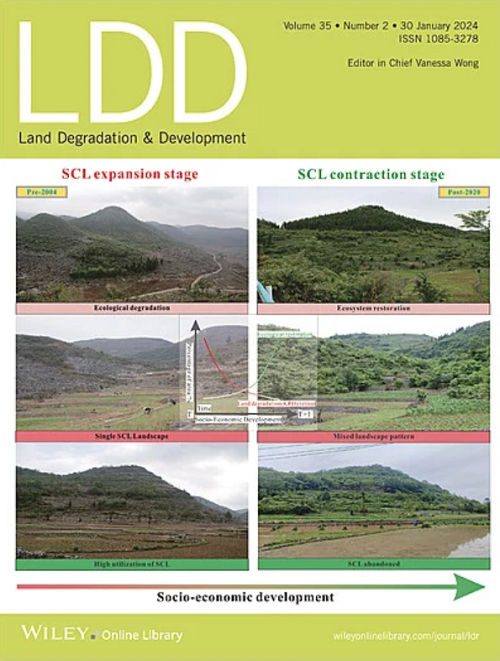长江经济带生态环境时空演变的主导因素是地形因子和气候因子的共同作用
IF 3.6
2区 农林科学
Q2 ENVIRONMENTAL SCIENCES
引用次数: 0
摘要
长江经济带是中国重要的生态环境保护屏障和经济引擎。了解其生态环境时空演化特征及其驱动机制,对于揭示生态系统结构和功能的变化具有重要意义。然而,由于城市化和气候变化的强烈耦合影响,生态环境的控制因素以及这些因素如何相互作用仍不清楚。本文构建了长期序列遥感生态指数(RSEI),对2000-2024年长江经济带生态环境变化特征进行了评价。随后,利用基于最优参数的地理探测器(OPGD)定量分析了生态环境演变的根本原因。结果表明:①长江经济带的平均RSEI值为0.68,整体生态环境质量较高,73%的区域RSEI值大于0.60;条件较好的地区集中在浙江、江西、贵州和湖南,条件较差的地区集中在云南西北部、四川西南部和湖北西部。(2)长江经济带EEQ主要呈现退化趋势,退化面积超过80%。在未来,大多数地区可能面临更高的生态退化风险。(3)数字高程模型(DEM)、温度(Tem)和人口(POP)是生态环境的关键驱动因子。某些因子之间存在显著的相互作用,DEM与潜在蒸散(Pet)之间的相互作用解释了62.2%的生态质量分布。研究结果有助于生态文明建设,为管理和保护生态环境提供政策建议。本文章由计算机程序翻译,如有差异,请以英文原文为准。
The Combined Effects of Topography and Climate Factors Dominate the Spatiotemporal Evolution of the Ecological Environment in the Yangtze River Economic Belt
The Yangtze River Economic Belt (YREB) is a key eco-environmental protection barrier and economic engine in China. Understanding the characteristics of its eco-environmental spatiotemporal evolution and mechanisms driving these changes is important for revealing shifts in ecosystem structure and function. However, the governing elements of the ecological environment and how these components interact remain unclear due to the strong coupling impact of urbanization and climate change. This paper constructed a long-term series remote sensing based ecological index (RSEI) to evaluate the characteristics of eco-environmental variation of YREB during 2000–2024. Subsequently, the fundamental reasons of the eco-environmental evolution were quantitatively analyzed using optimal parameters-based geographical detector (OPGD). Results indicated: (1) The average RSEI of YREB was 0.68, indicating a rather high overall eco-environmental quality (EEQ), with 73% of the region having RSEI values more than 0.60. The regions with excellent conditions were concentrated in Zhejiang, Jiangxi, Guizhou, and Hunan, while the poorer areas were in northwestern Yunnan, southwestern Sichuan, and western Hubei. (2) The EEQ of YREB mainly showed a degradation trend, with degraded areas exceeding 80% over the past 25 years. In the future, most areas might face higher risks of ecological degradation. (3) Digital elevation model (DEM), temperature (Tem), and population (POP) were key driving factors of the ecological environment. There were significant interactions between certain factors, with the interaction between DEM and potential evapotranspiration (Pet) explaining 62.2% of the ecological quality distribution. The findings assisted the creation of an ecological civilization by offering policy proposals for managing and conserving ecological environments.
求助全文
通过发布文献求助,成功后即可免费获取论文全文。
去求助
来源期刊

Land Degradation & Development
农林科学-环境科学
CiteScore
7.70
自引率
8.50%
发文量
379
审稿时长
5.5 months
期刊介绍:
Land Degradation & Development is an international journal which seeks to promote rational study of the recognition, monitoring, control and rehabilitation of degradation in terrestrial environments. The journal focuses on:
- what land degradation is;
- what causes land degradation;
- the impacts of land degradation
- the scale of land degradation;
- the history, current status or future trends of land degradation;
- avoidance, mitigation and control of land degradation;
- remedial actions to rehabilitate or restore degraded land;
- sustainable land management.
 求助内容:
求助内容: 应助结果提醒方式:
应助结果提醒方式:


